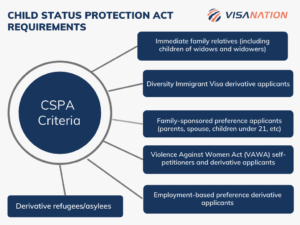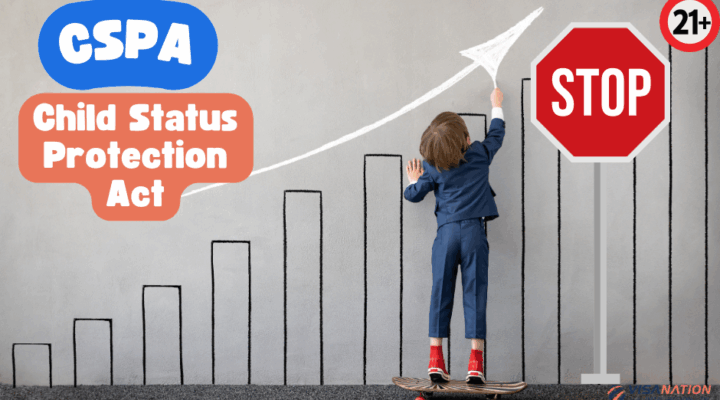For many children of immigrants, the long wait for a visa can lead to a problem, which is aging out. The Child Status Protection Act (CSPA) is a vital law designed to prevent this, and it protects the child status for individuals who have aged out (turned 21) before their visa was issued as a result of processing visa delays.
Learn from Attorney Malik as she breaks down the Child Status Protection Act (CSPA), explains how it protects your child’s status, and guides you through the eligibility criteria and application process. Click below to watch the video.
What is Aging Out?
Aging out is when a child turns 21 before their green card application is processed. Under U.S. immigration law (Immigration and Nationality Act (INA)), a child is defined as someone who is unmarried and under 21 years old. Once they reach 21, they are no longer considered an immediate relative and are moved into another visa preference category, which includes longer wait times.
Prior to CSPA being enacted in 2002, a child turning 21 would lose the child’s place in line and put them into a long waiting queue. CSPA was a solution that uses a formula to calculate someone’s “CSPA age,” allowing some individuals who turn 21 to still be considered a child for immigration purposes. However, they must still be unmarried to qualify.
CSPA Age Out Calculator
Child Status Protection Act (CSPA) Age Calculator
Estimate potential "age out" protection for immigration purposes.
Important USCIS Policy Update (Effective Aug. 15, 2025):
This calculator reflects the current USCIS policy, which clarifies that the CSPA age calculation is based on the Final Action Dates chart of the Visa Bulletin. If your application was pending before this date, different rules may have applied. Please consult an immigration attorney.
Calculation Results
Age at Visa Availability:
Petition Pending Time:
Calculated CSPA Age:
Disclaimer:
This calculator is for informational purposes only and is not legal advice. CSPA law is complex and subject to change and interpretation. The results do not guarantee any immigration benefit. You must consult with a qualified immigration attorney for advice on your specific case.
Child Status Protection Act Eligibility
The following are CSPA criteria:
- Immediate family relatives (including children of widows and widowers)
- Family-sponsored preference applicants (parents, spouse, children under 21, etc)
- Violence Against Women Act (VAWA) self-petitioners and derivative applicants
- Employment-based preference derivative applicants
- Diversity Immigrant Visa derivative applicants
- Derivative refugees
- Your CSPA age is the age you were when your refugee parent or petitioner on Form I-730 filed their I-590; also, the same as the date of their interview with USCIS
- Derivative asylees
- Your CSPA age is the age you were when your asylee parent or petitioner on Form I-730 filed their Form I-589

You are eligible for the Child Status Protection Act (CSPA) if you are applying for a Green Card in parallel to one of the aforementioned categories and your I-485 or one of the forms below was filed or considered pending on or after August 6, 2002:
- Form I-130, Petition for Alien Relative;
- Form I-360, Petition for Amerasian, Widow(er), or Special Immigrant;
- Form I-140, Immigrant Petition for Alien Worker;
- Form I-526, Immigrant Petition by Alien Entrepreneur;
- Form I-589, Application for Asylum and for Withholding of Removal;
- Form I-590, Registration for Classification as a Refugee
- Form I-730, Refugee/Asylee Relative Petition
What is a derivative applicant?
A derivative applicant is someone who is an intending immigrant but can’t be directly petitioned for. However, they can receive the capacity to adjust their status through the principal applicant. The principal applicant (listed on Form I-485, for example) is the main person intending to immigrate on the petition.
For example: We have a client named Fred. Fred is a citizen of Brazil who has a young child of 12 years old. Fred’s wife is a U.S. citizen who petitioned for him to get permanent resident status, and his daughter was listed on the I-485 petition as well. Fred’s daughter is listed as a derivative under Fred’s green card application, and as long as she remained unmarried she is protected under CSPA.
Unmarried children under the age of 21 and a spouse would be considered derivative applicants if the parent/spouse was qualified as the principal applicant. This is not the case for individuals who are the children or spouses of U.S. citizens because they are considered immediate relatives for immigration purposes.
Do you need clarification on how to calculate your child’s CSPA date? Speak to one of our attorneys.
Child Status Protection Act Calculator
For Asylees and Refugees
If you were under the age of 21 at the time your parent filed Form I-589, your age is frozen as of that date and you will not age out. Unlike derivative refugees, you must be unmarried in order to qualify for a grant of derivative asylum and to qualify for a Green Card under INA section 209.
For Immediate Relatives
Those who fall under the immediate relative category are the child of a U.S. citizen or are self-petitioning under the Violence Against Women Act (VAWA) or derivative. Your CSPA age is the one when Form I-130 or Form I-360 is filed. You are eligible for CSPA and will not age out if, at the time when the petition was submitted, you were under 21 years old.
What if my husband/wife dies before our petition, and my immediate relative’s spousal petition is approved? If this happens, your Form I-130 is automatically converted to a widow (er)’s Form I-360. Any children of the widow(er) who are younger than 21 and not married can be classified as derivatives on Form I-360 and qualify under the Child Status Protection Act.
For Family and Employment Preference/Diversity Visa Immigrants
Those who fall into this category can calculate their CSPA age by subtracting the number of days your petition was pending from your age on the date an immigrant visa becomes available to you. Cannot be married to qualify.
Child Status Protection Act Calculator Formula:
Age at Time of Visa Availability – Pending Time = CSPA Age
The visa availability date for the CSPA age calculation is based on the Final Action Dates chart in the Visa Bulletin, not the “Dates for Filing” chart. This change took effect on August 15, 2025, making it slightly more difficult for some children to qualify for CSPA protection, as the Final Action Dates are often many years behind the Dates for filing.
CSPA Immigration Frequently Asked Questions
Below you will find answers to the most commonly asked questions:
Does CSPA apply to family-based and employment-based categories?
Yes, CSPA applies to both family and employment-based categories.
How does CSPA calculate age?
The formula used to calculate an individual’s age will depend on which immigrant category they fall under. For family and employment preference and diversity visa immigrants, the calculation is (Age at Time of Visa Availability) subtract (Pending Time).
Step 1: Identify the Visa Availability Date (This is the date when a visa number becomes available for you, according to the official Final Action Dates chart in the U.S. State Department Visa Bulletin)
Step 2: Calculate the pending time (This is the number of days between when the initial filing was filed and when it was approved)
Step 3: Subtract the pending time (from step 2) from your age on the Visa Availability Date (step 1)
Result = CSPA Age
What does CSPA stand for?
CSPA stands for the Child Status Protection Act, which was enacted back in 2002.
Can a parent file for a child over 21?
Yes, U.S. citizen parents are able to petition for their foreign-born children even if they are past 21 years old. The processing time can be upwards of years.
Ready to start your child’s green card application?
How many years does it take to petition a child over 21?
It can take anywhere from 3 years or longer for an unmarried child (of a U.S. citizen or green card holder) above the age of 21 to get their I-130, Petition for Alien Relative, approved. After that happens, they must wait for an immigrant visa number to become available per the country caps.
How long does it take for NCV to send an interview letter in 2025?
According to the travel.state.gov site, the National Visa Center is aiming to schedule appointments within 3-6 months of receiving all the requested documentation. The processing time ranges per the embassy or consulate’s caseload.
When did the CSPA age freeze?
The Child Status Protection Act was enacted in 2002. The point at which an immigrant’s age freezes will depend on a number of factors, including the immigrant category they fall into and if they are a principal or derivative applicant, among other factors.
Does CSPA apply to the F4 category?
Yes, the CSPA does apply to the F4 category. When checking the visa bulletin, look at the preference category. Children under 21 of LPRs are in visa preference category F2A, while those above 21 are in category F2B and called “sons” and “daughters”. This matters because there is a staggering difference in wait times between these two categories. Check the latest visa bulletin here.
How does CSPA work for K-4 visa holders?
If you entered on a K-4 visa (which means that you were the child of a K-3 spouse), and your U.S. citizen step-parent married your K-3 visa parent before your 18th birthday, and filed the I-130 application before your 21st birthday, then you are protected as a child (immediate relative) under the filing. Your age has essentially been frozen, as the application was filed before you turned 21 years old.
Documents Required for CSPA Determination
- DS-260 confirmation page
- Valid passport and birth certificate
- Evidence of the marital status of the child and principal applicant
- Non-refundable visa application processing fee $325









